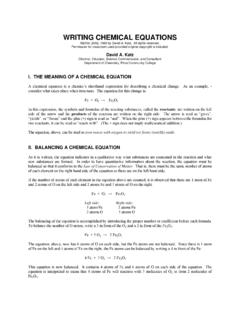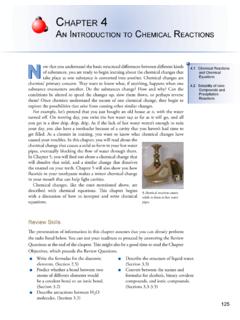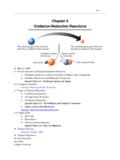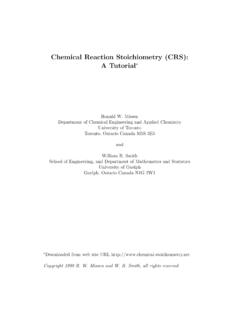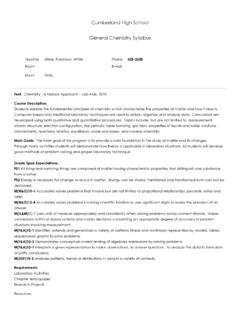Transcription of Chemistry - Mrs. Bauck, PHUHS Topic 1: Chemical …
1 Chemistry - Mrs. Bauck, PHUHS . Unit 6: The Mole concept and Chemical reactions - Chapters 8, 9, (18 - Chem 1H only). State Standards (** = Chem 1H only). Topic 1: Chemical Equations (AA) Characterize types of Chemical reactions , for example: redox, acid-base, synthesis, and single and double replacement reactions . Apply the mole concept and the law of conservation of mass to calculate quantities of chemicals participating in reactions . ** Describe oxidation-reduction reactions in living and non-living systems. ** Explore the Law of Conservation of Energy by differentiating among open, closed, and isolated systems and explain that the total energy in an isolated system is a conserved quantity. Topic 2: Mole concept Apply the mole concept and the law of conservation of mass to calculate quantities of chemicals participating in reactions .
2 Students will be able to: Extensions/Applications Explain in detail how redox reactions work. Explain how stoichiometry is an extension of chapter 9. Students will be able to: chapter 8 & 18: Determine the type of Chemical reaction given the Chemical equation. Balance a Chemical equation. Complete a Chemical equation if no products are given. Relate the law of conservation of mass to balancing a Chemical equation. Chem 1H chapter 18: Describe how redox reactions work. (Chem 1H chapter 18) Define oxidation and reduction, and be able to and be able to identify substances that are oxidized and reduced in an equation. Define and be able to identify oxidizing agents and reducing agents in Chemical equations. Define and be able to identify oxidizing agents and reducing agents in Chemical equations.
3 Be able to determine the oxidation number of an element in a compound or polyatomic ion. Learning Goal (Derived from State Standard) chapter 9: Define a mole as a unit used for counting atoms, molecules and formula units. Differentiate between atoms, ions, molecules, and formula units. State the value of Avogadro's number. State the value of the molar volume of a gas at STP. Calculate molar mass of an element or a compound. Define the conditions for STP. Calculate molar mass of an element or a compound. Convert between moles , particles, mass, and volumes (of gases) in a sample of substance in one-step math problems. Convert between moles , particles, mass, and volumes (of gases) in a sample of substance in two-step math problems. Be able to calculate gas density problems.
4 Be able to calculate percent composition/percent by mass. Be able to calculate empirical formulas. Be able to calculate molecular formulas. Students will be able to: Use the periodic table to identify metals and nonmetals. Determine the charge of a monatomic ion based on its placement in periodic table. Identify selected polyatomic ions and name them, and vice versa. Be able to name and wrote Chemical formulas for ionic compounds (BI, TI, OTHER). Required Skills or Background Knowledge to accomplish Learning Goal Be able to name and wrote Chemical formulas for covalent compounds (BM). Be able to round to the proper number of significant figures in all calculations. Be able to identify major acids, write their Chemical formulas, and dissociate/ uncrisscross them as needed: hydrochloric, acetic, nitric, carbonic, sulfuric, and phosphoric acids.
5 (Chem 1H) Be able to name binary acids and oxyacids. With help from a teacher, students will be able to: With help from the teacher, student has partial success with the goal Achieve partial success with and/or Even with help, student is unable to understand or complete any of the Even with help, the student has no success with the goal skills in scales through

